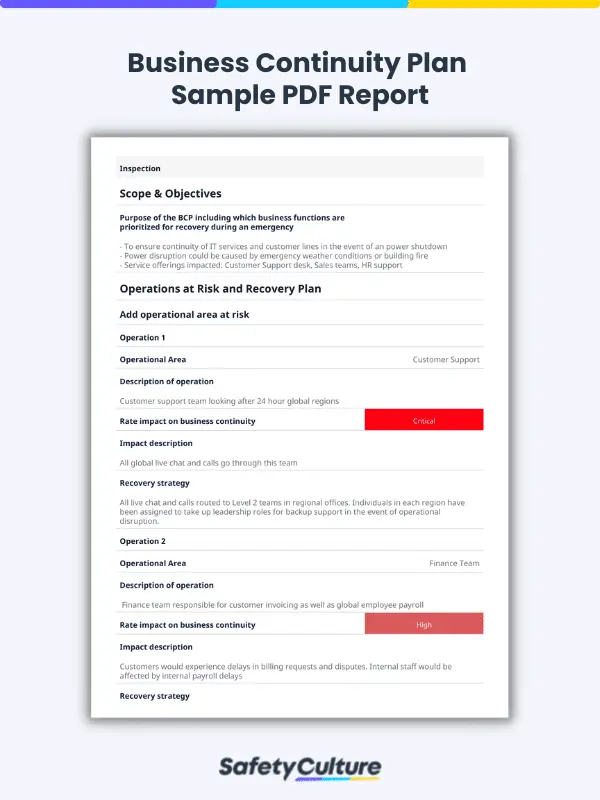What is a Business Continuity Plan?
A business continuity plan is a practical guide developed by companies to enable continuous operations in the event of major business disruptions like natural disasters and global lockdowns. Business continuity planning usually involves analyzing the impact of disrupted business processes and determining recovery strategies with management. Business continuity plans should be properly documented and tested through exercises for optimal effectiveness.
The goal of a business continuity plan is to strengthen the defense of businesses against various potential disruptions. It also aims to maintain critical business functions during unforeseen disasters.
Importance
Business continuity has increasingly become a top priority for organizations around the world. A BCP is important because it helps companies maintain essential functions amid or after emergencies, protecting their reputation and minimizing financial losses. Moreover, it helps employers stay on top of disruptive incidents and empower workers to complete job tasks confidently.
What are the 7 Elements of a Business Continuity Plan?
Business continuity planning enables businesses, small or large, to ensure resilient operations. For an effective plan, the following elements should be included:
- BCP Team – Amid a disaster or emergency, having a team or point person to go to will be essential. The BCP team will be responsible for planning and testing business continuity strategies. The background of each member of the BCP team can vary from organization managers or supervisors to specialists.
- Business Impact Analysis (BIA) – A BIA identifies, quantifies, and qualifies the impact of a loss, interruption, or disruption. Having a BIA will be essential in discovering risks that your business is exposed to and the potential disruptions that may occur.
- Risk Mitigation – This element pertains to the strategies against the risks that were discovered during the BIA. Risk mitigation strategies may include putting up security and safety systems in the workplace, conducting preventive maintenance of vehicles, machines, equipment, or any asset vital to operations, and training employees, among others.
- Business Continuity Strategies – A good BCP should establish strategies or alternate practices to keep the business running despite disruptions or disasters.
- Business Continuity Plan – The business continuity plan is a combination of findings from the performed BIA and the recovery strategies established by the organization. A BCP typically includes 4 key components: scope and objectives, operations at risk, recovery strategy, and roles and responsibilities.
- Training – All relevant personnel associated with the business continuity, disaster recovery, and incident response process should be trained according to the BCP plan that’s established and agreed upon.
- Testing – In this phase, strategies and plans are rehearsed or exercised to demonstrate their effectiveness. Testing the plan before rolling it out will enable the BCP team to discover potential flaws and fix them before they lead to damage or injury. It’s recommended to review and test the plan periodically to ensure that all protocols and strategies are up-to-date.
Achieve operational excellence
Cultivate a culture of excellence with our digital solutions that enhance efficiency, agility, and continuous improvement across all operations.
Explore nowHow to Write a BCP
Creating a business continuity plan seems to be a daunting task at first, especially for managers of operations, information technology, and human resources as they are often designated with this duty. As recommended by the International Labour Organization (ILO), listed below are general steps in developing a business continuity plan for small to medium-sized enterprises (SMEs):
- Step 1: Determine the risk profile through a self-assessment using the 4Ps framework—People, Processes, Profits, and Partnerships.
- Step 2: Identify key products, services, or functions.
- Step 3: Establish the business continuity plan objectives.
- Step 4: Evaluate the potential impact of disruptions to the business and its workers.
- Step 5: List actions to protect the business.
- Step 6: Organize contact lists.
- Step 7: Maintain, review, and continuously update the BCP.
Create your own Business Continuity Plan checklist
Build from scratch or choose from our collection of free, ready-to-download, and customizable templates.
Browse Business Continuity Plan checklistsExample
When planning for business continuity, it helps to break down its elements into quickly-understood segments. Keeping the plan user-focused can also help ensure usability and promote transferability. The following is a brief business continuity plan example:
Scope and Objectives:
This BCP is to ensure the continuity of IT services and customer lines in the event of an unforeseen and prolonged power shutdown. Power disruption could be caused by emergency weather conditions or a building fire. Functional areas that are prioritized for recovery in this BCP include the customer support desk and finance team.
Operations at Risk:
Operation: Customer Support
Operation Description: Customer support team looking after 24-hour global operations of live chat and customer calls for US, EMEA and APAC regions
Business Impact: Critical
Impact description: 100% of live chats go through the customer support team in Manila. 20% of live calls are routed to Manila office. A disruption would mean no more live chat support and customers experiencing significant wait times on calls Project timeline and team schedules
Recovery Strategy:
IT personnel and BCP committees should operate alternate backup programs and servers to help save customer requests after power outage. Customer support should be able to receive the requests and respond to customers within 30 minutes. IT Director should operate alternate server rooms in Area B if the power outage last more than an hour to prevent huge revenue loss.
Roles and Responsibilities:
Representative: Jon Sims
Role: Head of Operations
Contact Details: jsims@example.org
Description of Responsibilities:
1. Must ensure BCPs are updated and must coordinate with team leaders regarding changes
2. Helps notify key stakeholders in EMEA region of threats in Customer Support programs and tools
FAQs About Business Continuity Plans
The main difference between a business continuity plan and a disaster recovery plan is that the former encompasses the latter—that is, business continuity planning includes disaster recovery planning. ISO 22301:2019 is the international standard for Business Continuity Management (BCM) systems, and it outlines how specific plans for disaster recovery, incident preparedness, and emergency response may be needed rather than just one large plan for business continuity.
A business continuity plan should be tested at least every 6 months to verify the BCP’s effectiveness. Frequent testing can also allow the discovery of gaps and potential issues. This will help the organization update protocols and strategies accordingly.
Technology helps ensure a BCP’s critical data is backed up and can be quickly restored, maintaining reliable communication platforms for ongoing contact during disruptions, and enabling remote work capabilities to keep operations running smoothly. Automated monitoring tools help detect and respond to threats in real-time, enhancing overall resilience. Additionally, cloud services provide accessibility to applications and data from any location, ensuring business continuity.
Common mistakes to avoid when creating a BCP include neglecting to involve all relevant departments and stakeholders, failing to regularly update and test the plan, and not considering a wide range of potential risks. Additionally, overlooking the importance of clear communication and training for employees can lead to confusion and inefficiency during a disruption. Ensuring comprehensive coverage, regular maintenance, and thorough training can help avoid these pitfalls.





